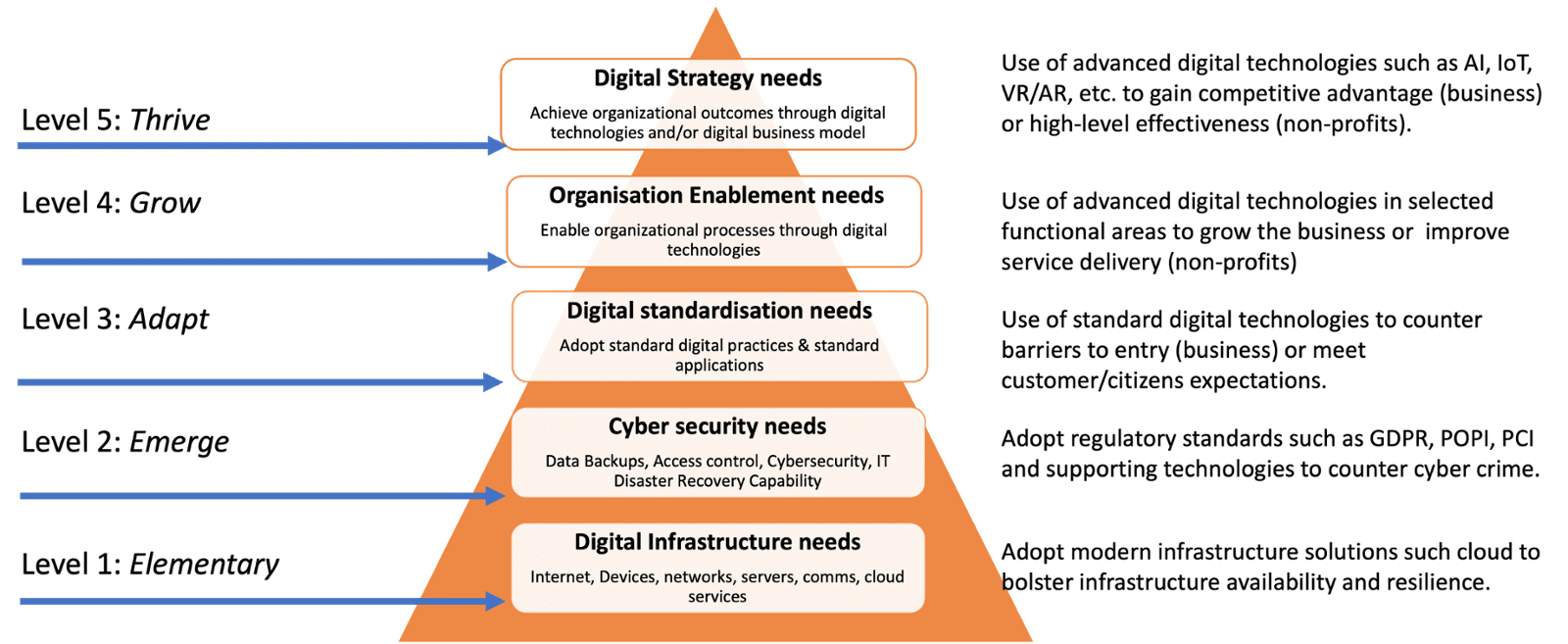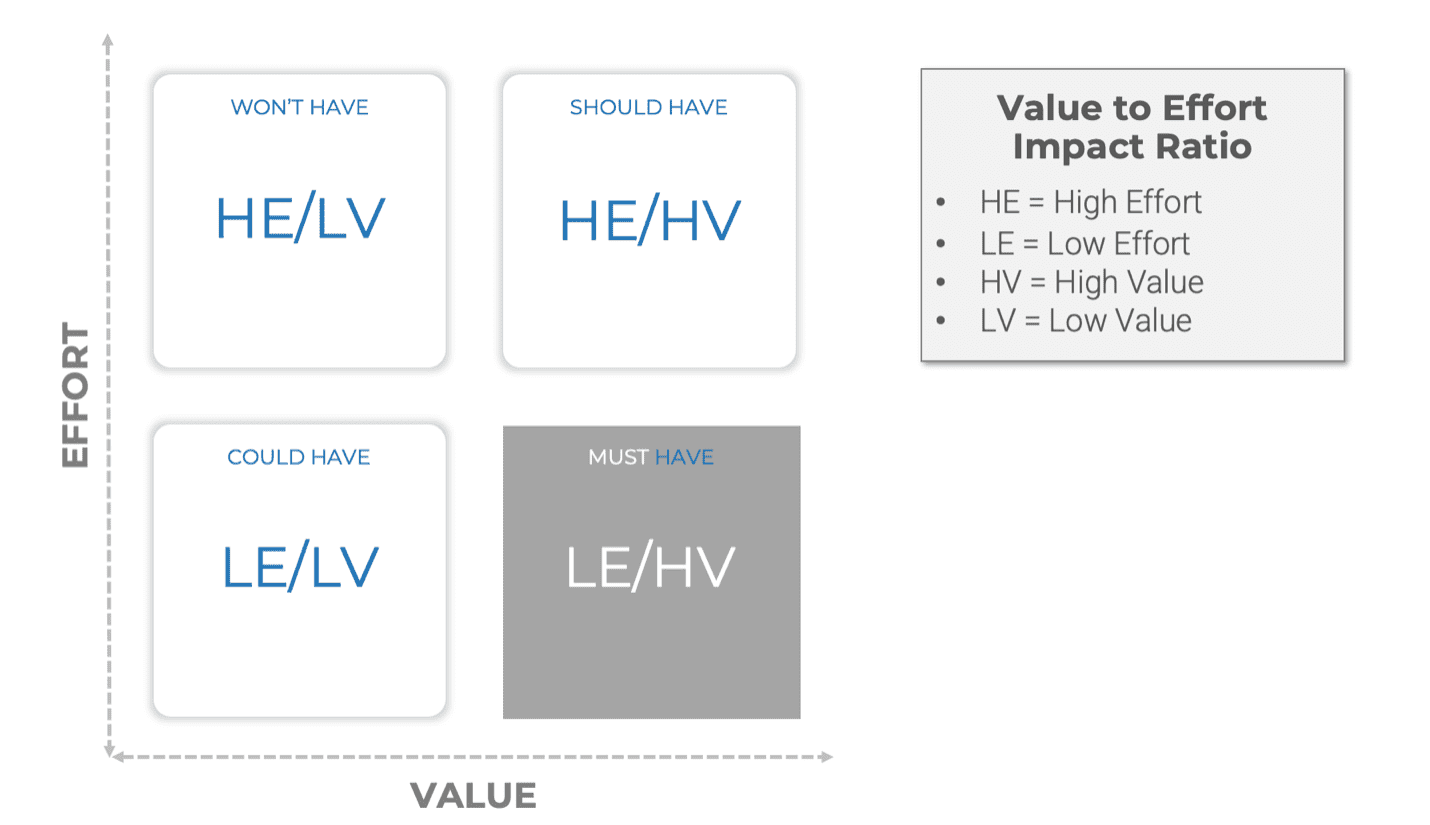Today's pace of technology advancement is rapidly and exponentially increasing, making it difficult for IT and Business Leaders to keep up to date. With almost every new technology comes opportunities and threats. If opportunities are missed the business might lose its competitive advantage in the industry. Threats may also come from vulnerabilities created by gaps in technology configuration. However, not all technology trends are relevant and/or useful to every organisation. IT and Business leaders need to be careful not to be carried away by fads and end up wasting precious resources. There is therefore a great need to know how to prioritise your IT needs to avoid unnecessary costs and threats and still keep abreast with technology advancements.
In this article we look at:
- The Hierarchy of IT Needs
- Defining Your IT Strategic Intent
- Aligning IT Needs to IT Strategic Intent

IT Hierarchy of Needs
The IT hierarchy of needs is derived from and aligned to Maslow's Human hierarchy of human needs. Organisational IT needs can be ranked in order of importance or criticality using corresponding Maslow's levels and their descriptions as seen in the diagram. Here's the description of the levels as they pertain to IT needs:
Level 1: Elementary
The Maslow's definition of this level relates to basic human survival needs including breathing, sleeping, eating, drinking (water) and getting warm. It is the physiological level of needs. The corresponding IT level of needs can be referred to as "Elementary" as they involve the basic need for "Digital Existence". This level represents the need to exist in the digital world and it involves having basic devices, connectivity, basic security in the form of anti-virus, data backups, basic office/productivity tools such as email applications, word processors, etc. Having a website and the ability to conduct online meetings has since become a basic need following the advent of the COVID-19 pandemic.
The reality brought about by the fourth industrial revolution (4IR) is that every organisation and individual these days need to have this basic technology capability. Individuals need cell phones to communicate and/or conduct basic transactions such as buying electricity, making payments, sending and receiving messages or receiving money, among many things. Businesses need technology to get paid for their sales, either to receive online or card payment, generate invoices, etc. Online meetings have proven to save costs, especially travel costs. Collaboration tools such as Microsoft Teams have become standard for many industries. It is therefore safe to refer to this level as "Digital Existence" and it is the basic level of IT needs.
Level 2: Emerge
Just like Maslow's Hierarchy of Human needs, this level is concerned with safety and security. The focus is on cybersecurity as the biggest concern in today's digital era. With the increase in the use of and dependency on digital technologies comes an increase in digital crime as criminals follow where people are. After establishing your presence in the digital world your existence needs to be secured.
Regulatory standards such as the European Union's (EU) General Data Protection Regulation (GDPR) and South Africa's Protection of Personal Information Act (POPIA) among others, are meant to protect individuals and organisations from cyber crime, i.e., theft, exposure and misuse of information. Compliance with these standards will help protect your organisation as well the customers that interact with you online. Data backups, disaster recovery and business continuity capabilities are critical for organisations to at least "stay afloat" in the "digital ocean" without being expert "swimmers". This level is hereby referred to as "Emerge" as it represents a more meaningful, safe and secure digital existence.
Level 3: Adapt
With the advancements in and rapid adoption of technology, what starts off as a tool or practice to give an enterprise a competitive advantage, quickly becomes a standard way of doing things and customers expect no less. For example, at some point online banking was something that gave some banks a competitive edge, but today a bank without online banking is imaginable. Online banking has become a barrier to entry for the banking industry just as ATM's were at some point in time. It is evident that the growth of digital banks (banks without brick and mortar) is also likely to change the business model for the entire banking industry. For this reason organisations need to adapt to new technologies as customer adoption increases. Your digital existence will not be sustainable if you do not adapt. Certain technologies are essential therefore to adapt to new realities in the industry.
Level 4: Grow
All organisations and businesses are created to achieve something. However, the capabilities to achieve and produce success are developed with time through a growth process. After successful adapting to once's environment, the next natural step is to grow and be what you always wanted to be. This applies to both individuals and organisations. The IT needs for organisations who have reached this stage involve those technologies that enable the achievement of business goals.
"Without continual growth and progress, such words as improvement, achievement, and success have no meaning." - Benjamin Franklin
A simple example is that of a company that wants to grow its customer base by using social media platforms. The pace at which things happen in the digital world is largely exponential. The digital space allows global reach that was never seen before and could hardly be anticipated. So, technologies such as digital platforms enable the achievement of business goals such as customer growth or improving customer experience.
Level 5: Thrive
This is the level that satisfies the need to achieve competitive advantage or create a niche. It can be achieved by harnessing advanced technologies such as Artificial Intelligence (AI), Virtual Reality (VR), Augmented reality (AR), Advanced Data Analytics, etc. to create new business models and/or disrupt a whole industry. It should be noted that these advanced technologies are built from existing or foundational technologies that are part of the lower level needs. The increase in popularity and adoption of AI technologies such as ChaTGPT, and Google Assistant can be attributed to the desire for businesses to differentiate themselves.
As it has been the case with all new technologies, after the adoption has been wide enough, the technology becomes standard and define the business model. At this stage such technology becomes a need for level 3 for organisations that need to adapt to the new reality in order to survive, and level 4 for those that need to use these technologies to achieve business goals.
Define Your Strategic Intent

All organisations exist for a purposes. Generally, non-profit organisations exist to meet a social need or achieve certain socio-political or religious goals. All businesses exist to meet a certain need in order to make a profit. Others, simply exist to make as much money as they can.
When it comes to technology, organisations decide if and how to use technology to achieve their main goal. This forms the basis of their strategic intent. After establishing their technology strategic intent, organisations can use the IT hierarchy of needs to prioritise the type of technology to adopt and implement. For example, if the strategic intent is to disrupt the industry by finding innovative ways of using technology to craft a niche, the organisation must prioritise technologies that are relevant at level 5, such as AI. And if the use of technology to achieve business goals is not part of the organisation's strategic intent, then the focus should be at level 3 technologies where the intention is to adapt and ensure that you are not left out. The technology strategic intent of an organisation is informed by many factors which are properly identified during the process of business analysis using tools or methods such as SWOT analysis, PESTEL and/or Risk Assessment.

- Aligning IT Needs to IT Strategic Intent
- Aligning IT Needs to IT Strategic Intent
The reality is that organisations IT needs do not always fall into one of the five levels described above at any given time. It is common that an organisation's technology strategic intent might point to level 5 technology needs and yet the prevailing situation could be that they lack critical level 2 needs such as adequate cybersecurity capability. Advanced technology is very intrusive and requires a good security foundation. Therefore, even though your needs as informed by your defined technology strategic intent might be at level 5, the priority might be to first address level 2 needs. This is where accurate prioritisation is needed and the priority mapping technique will come handy.
The adjacent diagram shows the MoSCoW (Must have, Should have, Could have, Would have) technique for prioritisation. You can use the method to categorise your business IT needs into the four quadrants shown on the diagram.
The High-Effort/Low-Value (HE/LV) quadrant represents the needs that will require a lot of effort and/or resources and yet yield low value. Many organisations have found themselves busy with initiatives in this category and not realising that they will yield low value benefits. Usually, peer pressure and the need to appear as advanced make people and organisations fall into the trap of spending high and achieving little.
The Low-Effort/Low-Value (LE/LV) quadrant represents the needs that are easy to meet but equally yield low value results. The last quadrant, Low-Effort/High-Value (LE/HV), is the ideal quadrant. If you can identify an opportunity to acquire low effort technology that will yield high value, jump on it immediately.
Upon thorough analysis of each need, you can map them into the relevant category. The HE/HV category can be postponed because the threat of competition is not immediate and you can buy yourself some time. However, in such cases it is advisable to start the digital transformation journey - be it at a reasonably slow pace.
The HE/LV category comprises those nice-to-have technologies which must be avoided at all cost.
The LE/LV category includes those technologies that might give your company a good reputation but not a high enough value. Because these are low effort, one could adopt and implement them if you have the time as having them will give your organisation a good reputation.
There are those technologies that are well-spoken of and highly recommended. If you analyse their potential you will discover that they are a game changer and are therefore very likely to give a competitive edge. If your business goal is to be unique and have a competitive advantage, you should consider these technologies. However, it takes a lot of effort to implement them. As such they fall under the High-Effort/ High-Value category and you should consider them. Depending on the prevailing circumstances in your business and your technology strategic intent you would not be forced to have these technologies.
Cybersecurity needs definitely fall into this category.





